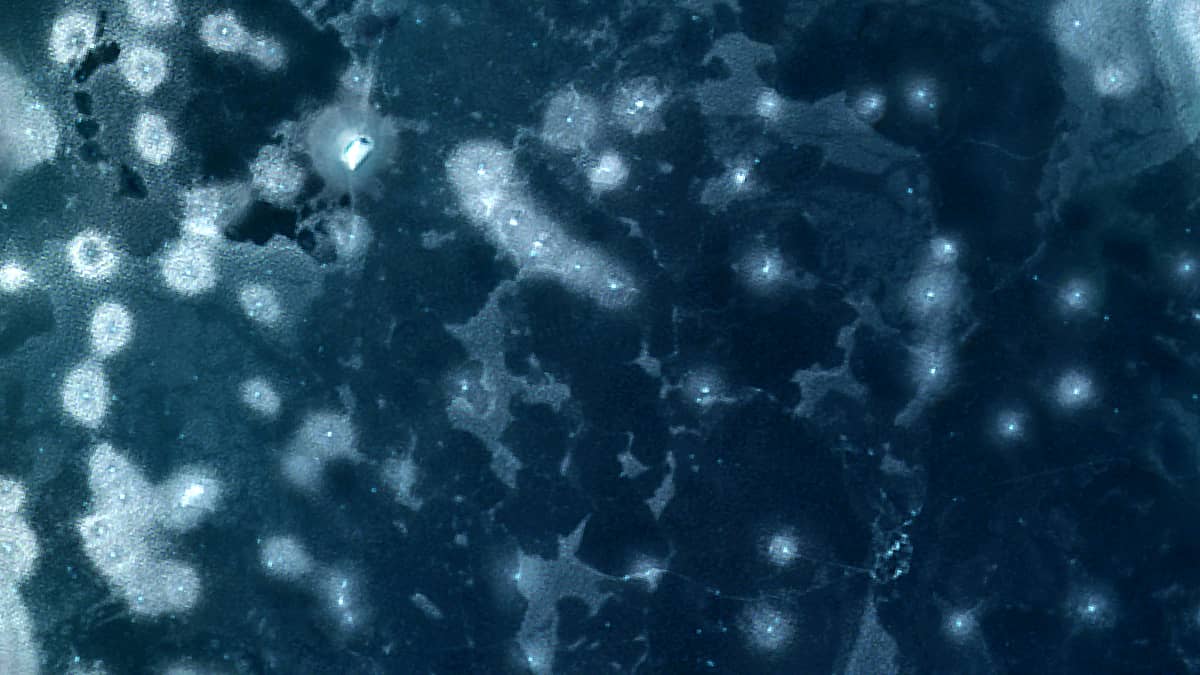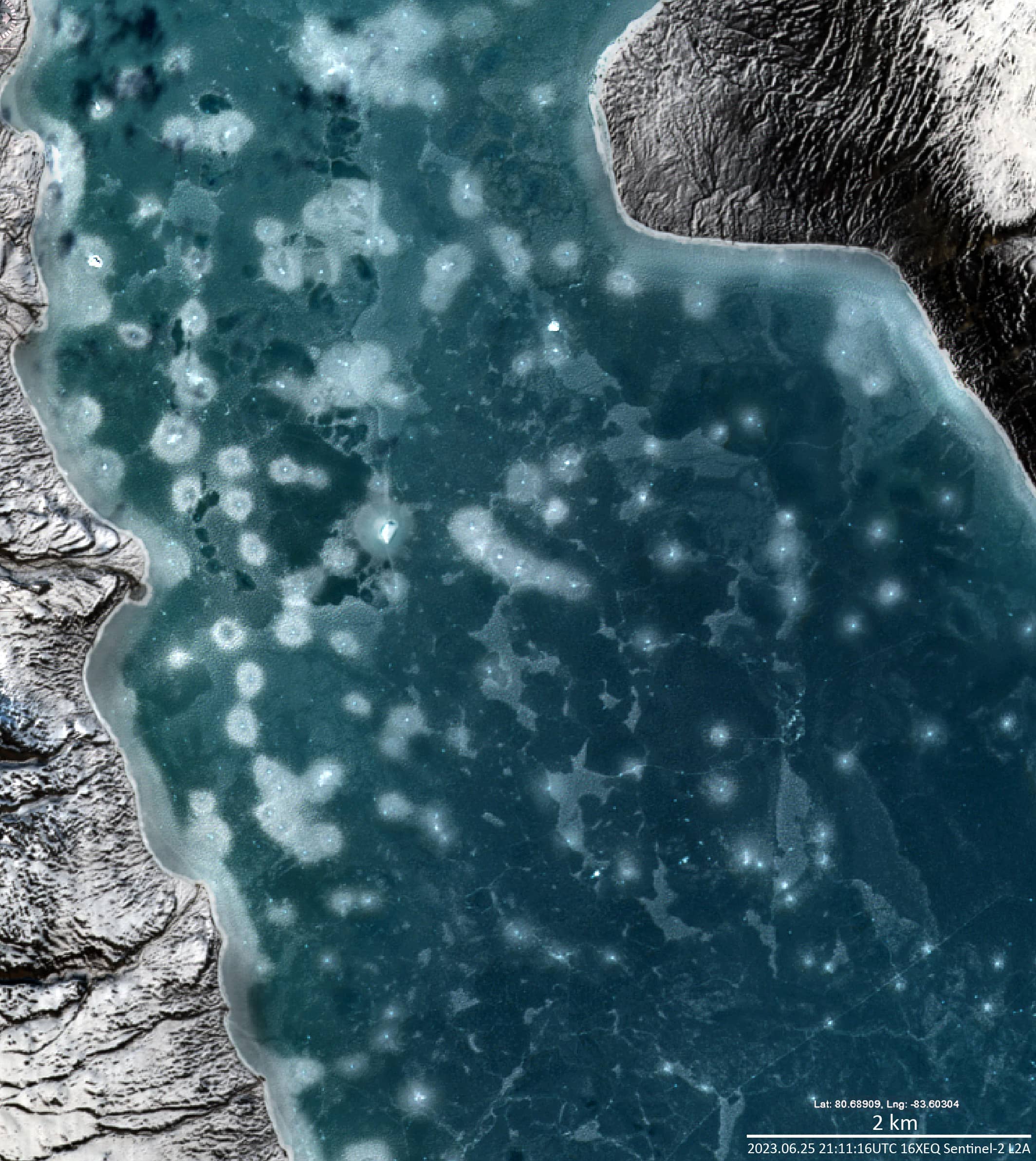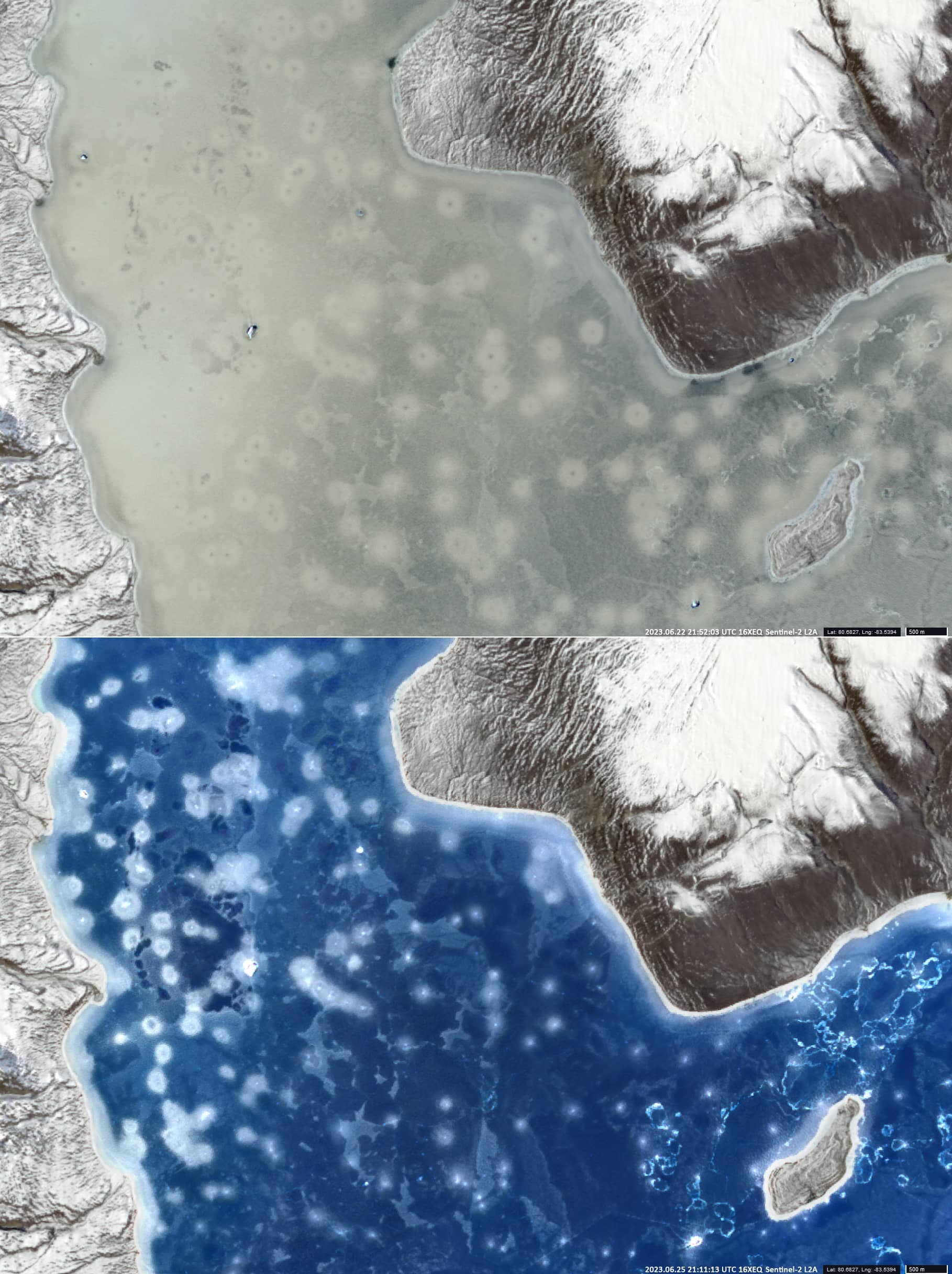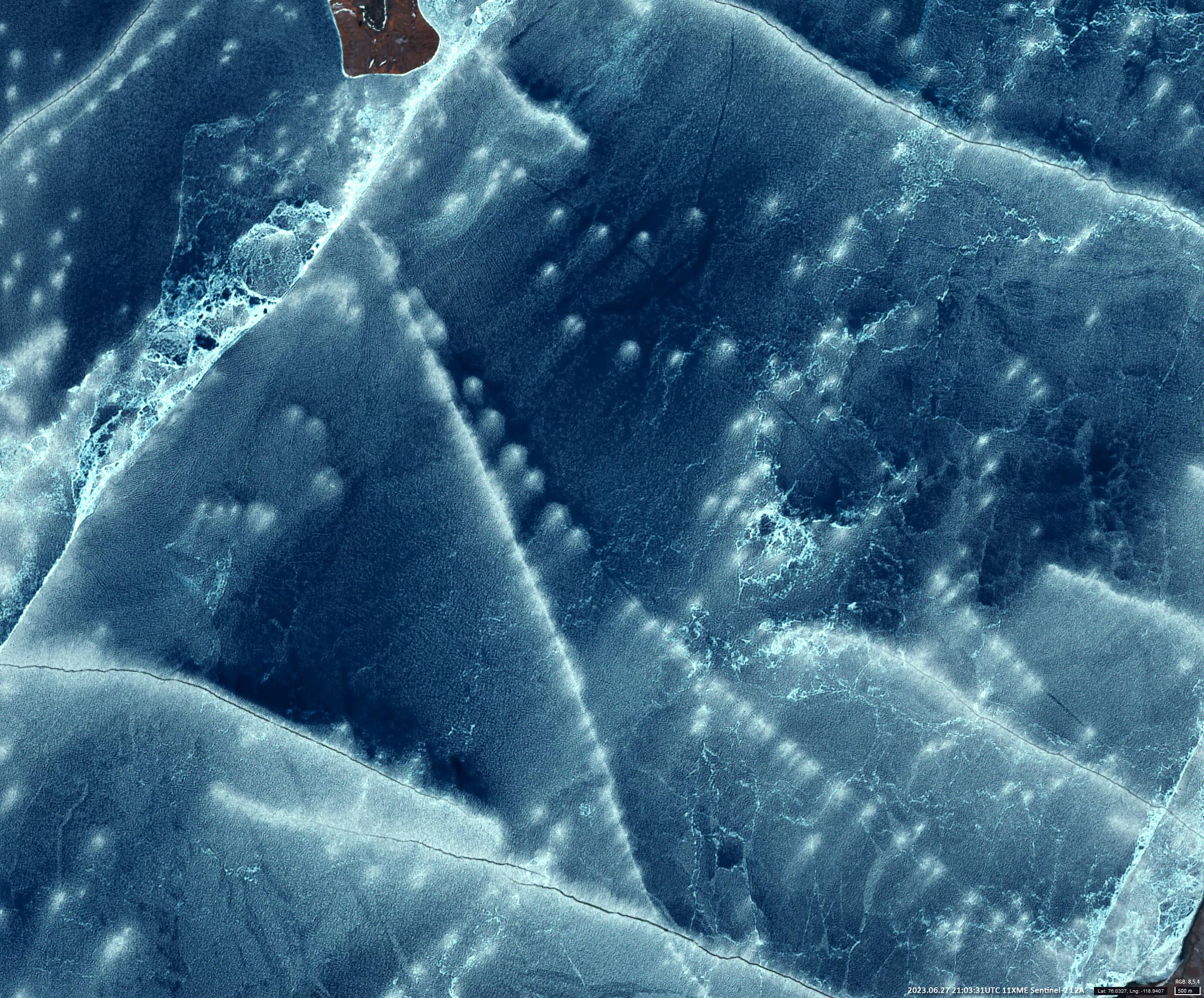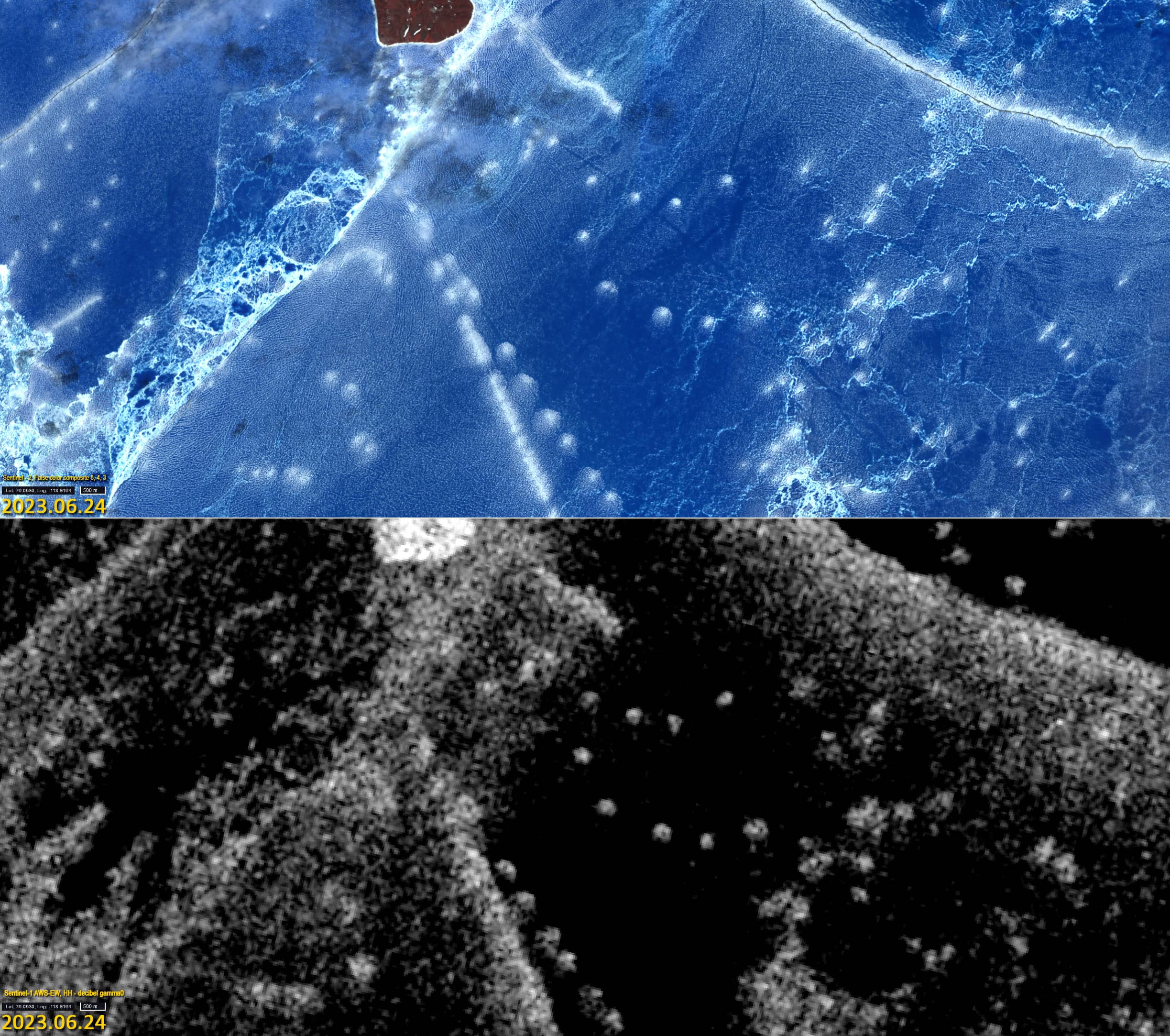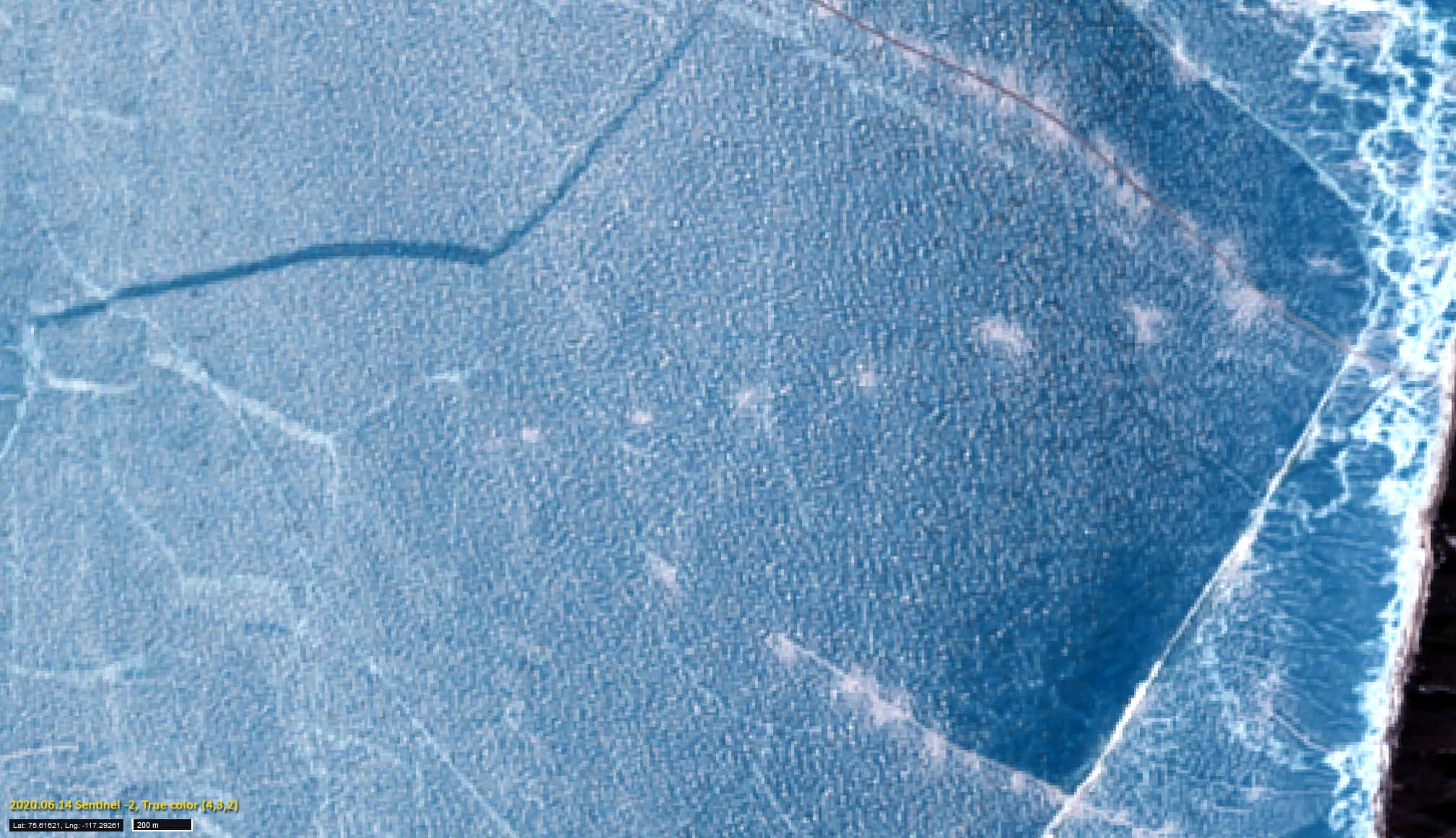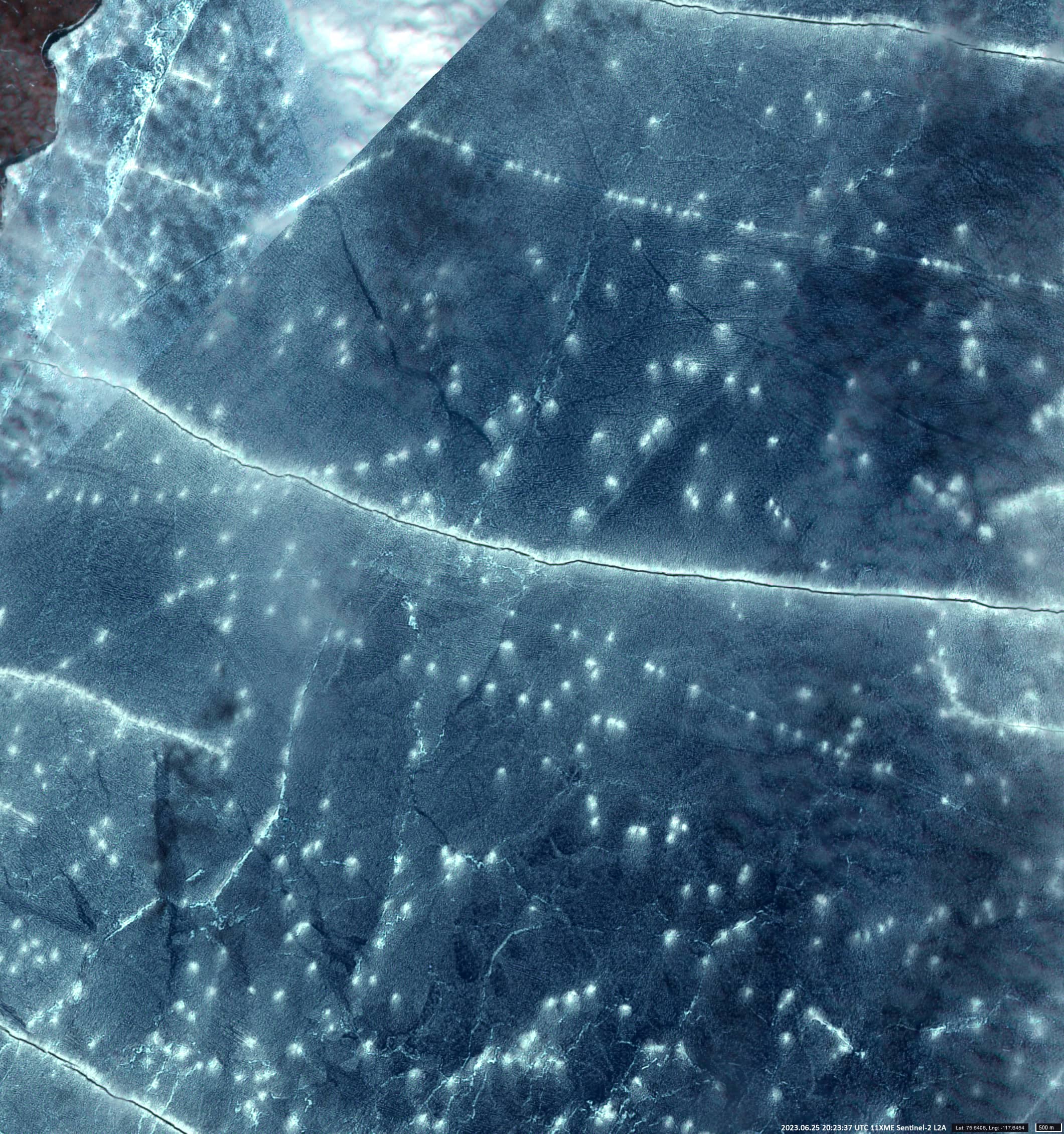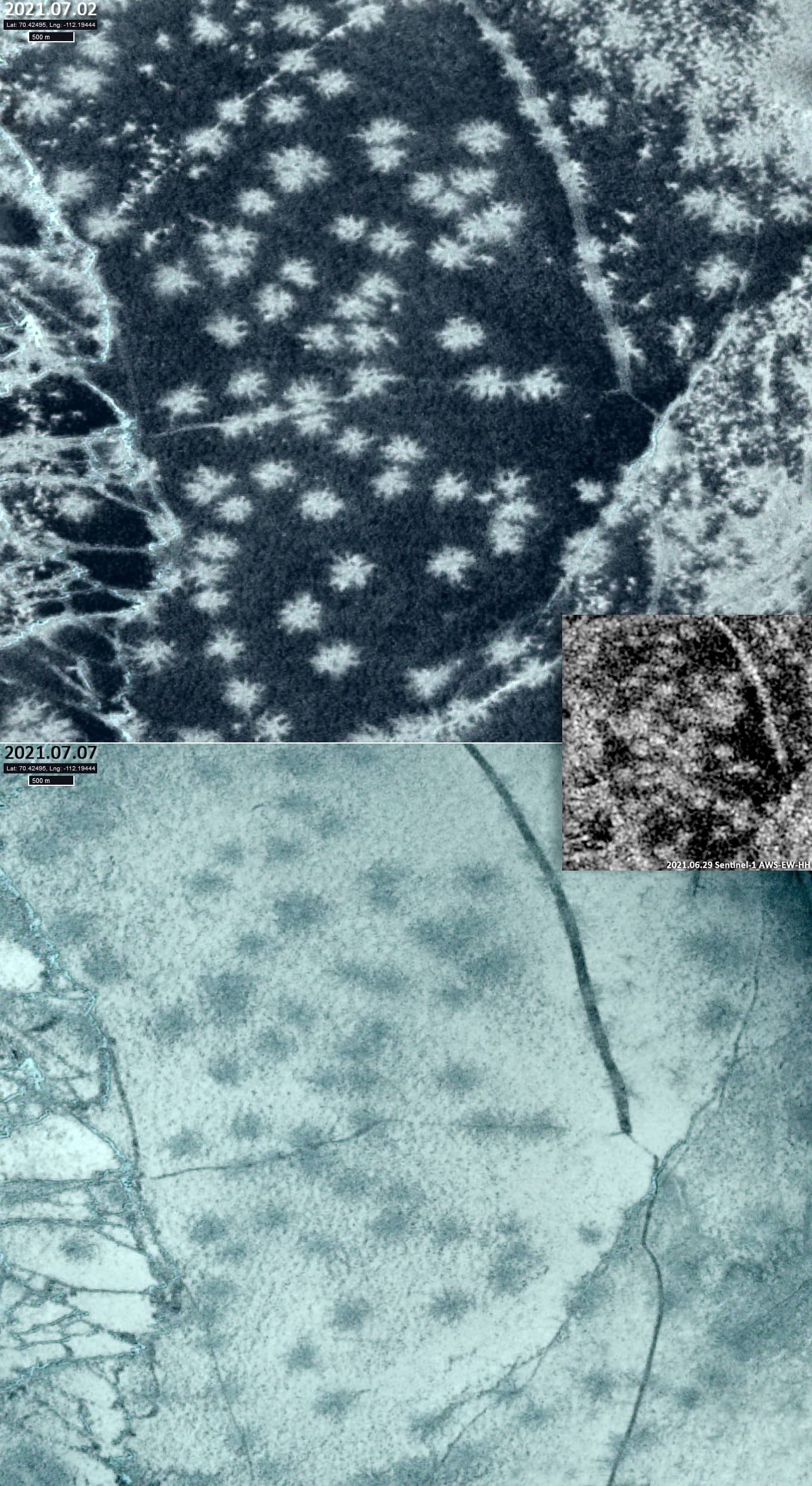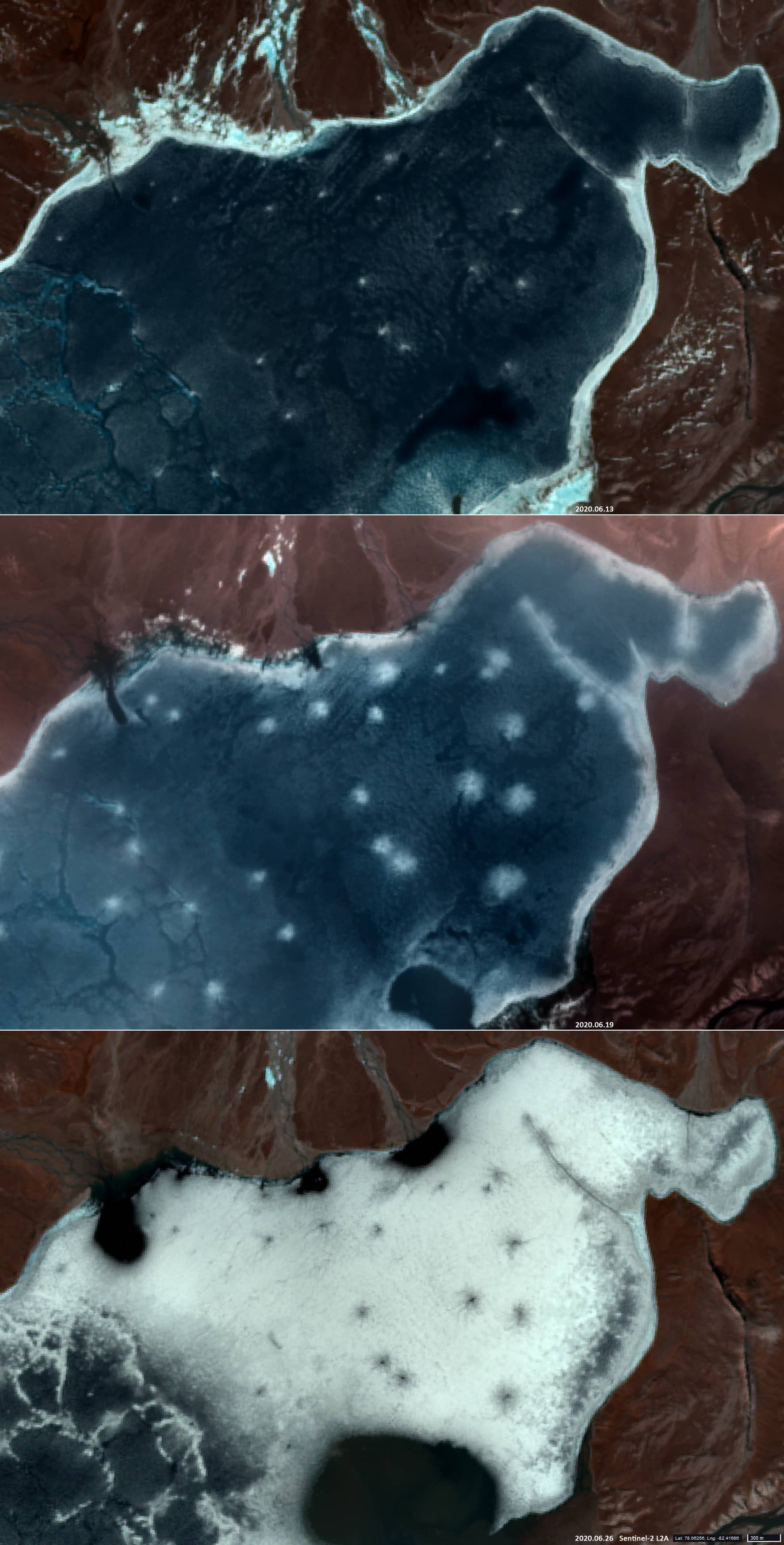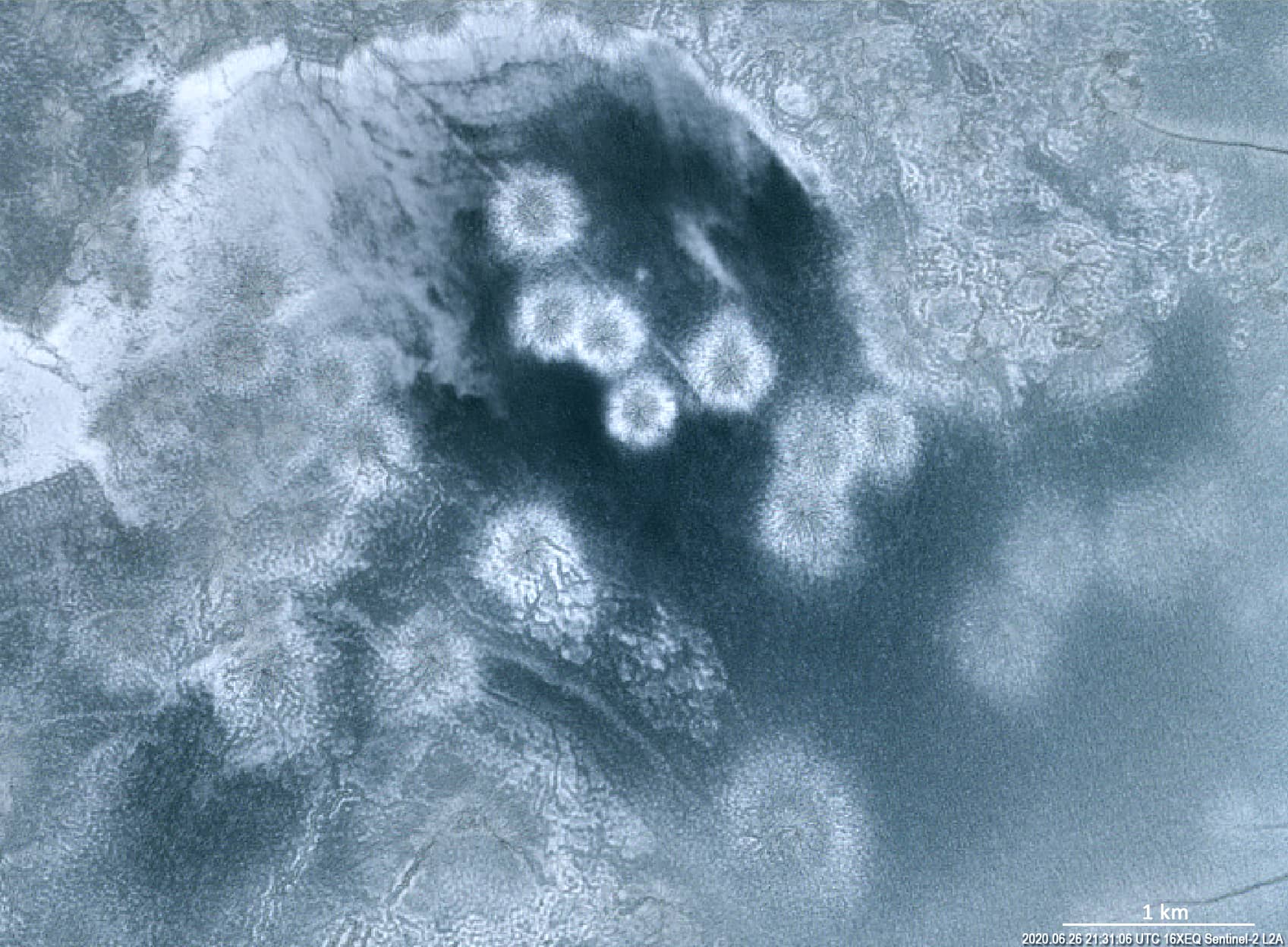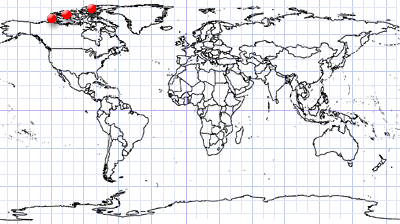
Circular Ice Formations in Polar Ocean
Canadian Arctic Archipelago
Dates of acquisition:
- June 25th, 2023 | 21:11:16 UTC
- June 22nd, 2023 | 21:11:16 UTC
- June 27th, 2023 | 21:03:31 UTC
- June 25th, 2023 | 20:23:27 UTC
- July 2nd, 2023 | 20:23:27 UTC
- June 26th, 2023 | 21:31:06 UTC
- June 25th, 2023 | 21:11:09 UTC
Sensors: Sentinel-2 L2A, Sentinel-1 AWS-EW HH
Coordinates ca.
- 80.5°N, 83.4°W;
- 76.2°N, 118.2°W;
- 70.5°N, 112.3°W
Each year in June-July, large numbers of circular, radially spreading patches of white and grey colour can be observed on the yet unmelted sea ice of the straits and bays around the islands of the Canadian Arctic Archipelago and near the Canadian Arctic coast. They grow over a period of two to four weeks, sometimes reaching up to one kilometre in diameter. The structures can be seen in all marine waters within the archipelago. However, they are particularly pronounced in relatively enclosed fjords and bays (e.g. Borup Fjord, D’Iberville Fjord, Atkinson Bay, etc.). These radially growing structures are particularly visible in a false-colour composite with near-infrared, red, and green bands (8, 4, 3 or 8, 5, 4). They are also visible in the true colour image. They appear (or become visible) when the ice becomes thin, semi-transparent (sea water shining through) and takes on saturated blue colors in the RGB range (8, 5, 4). The patches that appear on this blue ice seem to be randomly distributed, but are particularly associated with developing cracks [Fig. 2-a, 2-b, 3, 4].
It can be observed that these structures form around the nucleation centre [Fig. 1-a, 1-b, 7, 8]. They can be seen, for example, around small icebergs or their fragments frozen in sea ice. Judging from the Sentinel-1 radar images, these circular, radially expanding structures are located on the ice surface; in any case, the roughness of the ice surface in these structures distinguishes them from their surroundings, making them visible on the radar image [Fig. 2-b, 5]. According to the observations, the emergence of these formations occurs shortly before or shortly after the ice becomes semi-transparent. In any case, these formations are not visible on either Sentinel-2 or Sentinel-1 prior to “blue ice” conditions. After their appearance, the circular structures begin to grow for 2-4 weeks, reaching sizes of up to 500 m in diameter and in some rare cases up to 1 km [Fig. 1-a, 1-b, 5, 7, 8]. Afterwards, they can remain visible on lightly snow-covered ice as well as on broken ice floes of very thin, almost melted ice [Fig. 6]. This phenomenon could be explained as follows. As the water temperature rises and the sea ice becomes thinner, microcracks, or vertical pores, can form in the ice. One of the factors for their formation is thought to be dissolved salts, which are excluded from the solidification process of the ice. Other causes may be the tension of the ice sheet due to tides, water currents or the weight of the ice itself, which can contribute to the formation of cracks or holes due to the uneven density and thickness of the ice and the imperfection of the ice crystals. It can also be caused by foreign objects lying on or in the ice. Water is drawn into these microcracks by capillary action. Relatively fresh water from the nearer sub-ice layer flows up through the pores to the ice surface according to Darcy’s law (Darcy’s law for the filtration of liquids in a porous medium; it establishes a linear relationship between the volumetric flow rate of the liquid and the pressure drop in porous media). At the surface of the ice, temperatures are so low that the almost unsalted water freezes quickly and has little time to spread around the crack. Under the influence of relatively warm seawater, cracks and pores also expand, and the volume of water rising to the ice surface increases accordingly, with the water further away from the centre. Apparently, in this case, the forces of the tides, but also the effect of possible internal waves beneath the fast ice in narrow straits and bays, vibrations of the ice itself, etc., can cause water to flow through the enlarged holes in the ice. The water poured over the ice surface freezes. The structure grows radially. However, this process is uneven and rapid, tiny air bubbles dissolved in the freezing water and emerging ice crystals make the newly formed ice opaque. It is possible that when the ice is covered with new snow, the water coming from below melts it and the dark star-shaped structures form on the snow, this process has been described (left) [Fig. 6 (lower part)]. With time, the overgrown structures close in and can “cover” large areas with a continuous carpet [Fig. 7, 8, animation 1-a, 2-a]. When the conditions for new water inflow and freezing disappear, the radial structures stop growing, but they remain on the ice until it melts. As mentioned above, they disappear when the ice melts, but they can also disappear from the observer’s view when the temperature changes or when they are dusted by the snow that has fallen on the ice.
There is also an image of other structures on the ice surface [Fig. 9]. These look like long parallel stripes or folds; they are rarer and have a different origin.

